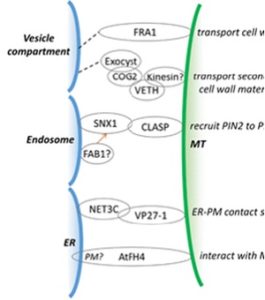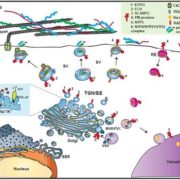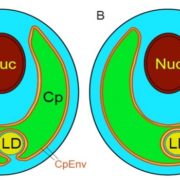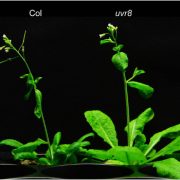Review: Emerging roles of cortical microtubule–membrane interactions ($)
 The plant cytoskeleton forms a dynamic and complex architecture in all plant cells and comes with a myriad number of functions, from allowing intracellular transport to regulating gene expression. In this review, Yoshihisa Oda focuses on the purposes of cortical microtubule (cMT) arrays, which are anchored to the plasma membrane and form highly-ordered structures. Oda goes beyond the conanical role of cMTs − cellulose synthase-complex movement along cMTs for cellulose microfibril deposition − and investigates what is known about the interaction of cMTs with various membrane structures. cMTs preferentially nucleate adjacent to preexisting cMTs to generate a branched or bundled network. This MT network typically forms a parallel array that connect to the plasma membrane and is maintained by such factors as Rho/Rac GTPase proteins (ROPs). On the other hand, in xylem vessel cells, ROP lateral diffusion is restricted by cMTs. In terms of abiotic stress, ABA treatment induces cMT disorganization, similarly seen during salt stress, in a manner involving the Arabidopsis phospholipase D isoform PLDα1. cMTs are also important for trafficking of non-cellulosic materials, as seen in newer studies investigating the kinesin FRAGILE FIBER1. Lastly, actin binding proteins and nucleating factors interact directly and indirectly to regulate cMT and ER dynamics. With advances in such tools as proteomic analysis and imaging techniques, cMT-membrane interactions will be easier to investigate and will facilitate our understanding of this process. (Summary by Alecia Biel) J. Plant Res. 10.1007/s10265.
The plant cytoskeleton forms a dynamic and complex architecture in all plant cells and comes with a myriad number of functions, from allowing intracellular transport to regulating gene expression. In this review, Yoshihisa Oda focuses on the purposes of cortical microtubule (cMT) arrays, which are anchored to the plasma membrane and form highly-ordered structures. Oda goes beyond the conanical role of cMTs − cellulose synthase-complex movement along cMTs for cellulose microfibril deposition − and investigates what is known about the interaction of cMTs with various membrane structures. cMTs preferentially nucleate adjacent to preexisting cMTs to generate a branched or bundled network. This MT network typically forms a parallel array that connect to the plasma membrane and is maintained by such factors as Rho/Rac GTPase proteins (ROPs). On the other hand, in xylem vessel cells, ROP lateral diffusion is restricted by cMTs. In terms of abiotic stress, ABA treatment induces cMT disorganization, similarly seen during salt stress, in a manner involving the Arabidopsis phospholipase D isoform PLDα1. cMTs are also important for trafficking of non-cellulosic materials, as seen in newer studies investigating the kinesin FRAGILE FIBER1. Lastly, actin binding proteins and nucleating factors interact directly and indirectly to regulate cMT and ER dynamics. With advances in such tools as proteomic analysis and imaging techniques, cMT-membrane interactions will be easier to investigate and will facilitate our understanding of this process. (Summary by Alecia Biel) J. Plant Res. 10.1007/s10265.









